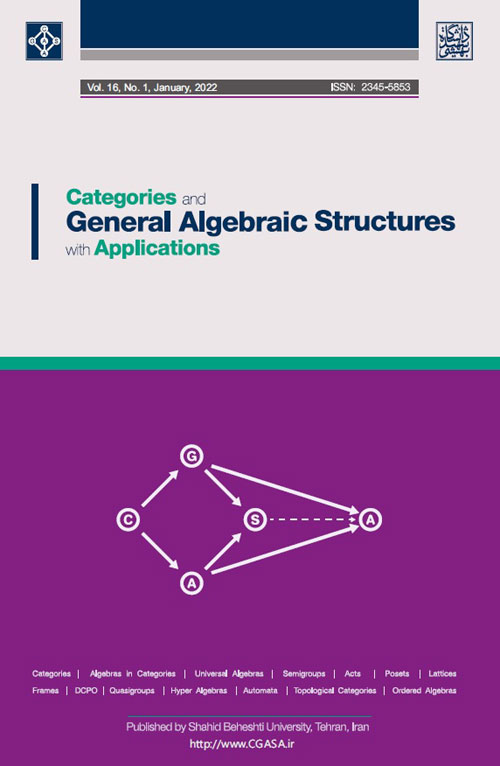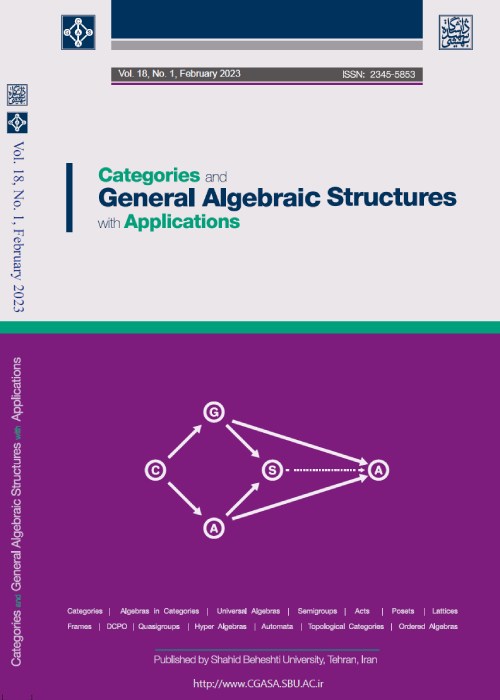فهرست مطالب

Categories and General Algebraic Structures with Applications
Volume:16 Issue: 1, Jan 2022
- تاریخ انتشار: 1400/10/27
- تعداد عناوین: 8
-
-
صفحات 29-58
-
صفحات 105-141
-
صفحات 143-187
-
صفحات 189-220
-
صفحات 221-248
-
صفحات 249-267
-
Pages 1-28
The systematic study of planar semimodular lattices started in2007 with a series of papers by G. Grätzer and E. Knapp. These lattices haveconnections with group theory and geometry. A planar semimodular latticeL is slim if M3 it is not a sublattice of L. In his 2016 monograph, “TheCongruences of a Finite Lattice, A Proof-by-Picture Approach”, the secondauthor asked for a characterization of congruence lattices of slim, planar,semimodular lattices. In addition to distributivity, both authors have previouslyfound specific properties of these congruence lattices. In this paper,we present a new property, the Three-pendant Three-crown Property. Theproof is based on the first author’s papers: 2014 (multifork extensions), 2017(C1-diagrams), and a recent paper (lamps), introducing the tools we need.
Keywords: Rectangular lattice, patch lattice, slim semimodular lattice, Congruence lattice, lattice congruence, Three-pendant Three-crown Property -
Pages 29-58
As an essential tool in homological algebra, tensor products play a basic role in classifying and studying modules. Since hypermodules are generalization of modules, it is important to generalize the concept of the tensor products of modules to the hypermodules. In this paper, in order to achieve this goal, we present a more general form of the definition of hypermodule. Based on this new definition, some of the required concepts and properties have been studied. By obtaining a free object in the category of hypermodules, the notion of tensor product of hypermodules is provided and some of its properties are studied.
Keywords: Hypermodule, Free object, tensor product -
Pages 59-104
Up to term equivalence, there are three ways to assign a nonemptyset C of constants to the three-element Kleene lattice, leading toternary algebras (C = {0, d, 1}), Kleene algebras (C = {0, 1}), and don’tknow algebras (C = {d}). Our focus is on ternary algebras. We derivea strong, optimal natural duality and the restricted Priestley duality forternary algebras and give axiomatisations of the dual categories. We applythese dualities in tandem to give straightforward and transparent proofsof some known results for ternary algebras. We also discuss, and in somecases prove, the corresponding dualities for Kleene lattices, Kleene algebrasand don’t know algebras.
Keywords: Ternary algebra, Kleene algebra, Kleene lattice, natural duality, Priestley duality -
Pages 105-141
We consider certain pairs (A, T) where A is a (multi)ring andT ⊆ A is a multiplicative set that generates, by a convenient quotient construction,a (multi)structure that supports a quadratic form theory: withsome natural hypotheses we generalize constructions previously presentedin [3] and [6]. This also provides some steps towards an abstract formallyreal quadratic form theory (non necessarily reduced) were the forms havegeneral coefficients (non only units).
Keywords: quadratic forms, special groups, real semigroup, multirings, hyperfields -
Pages 143-187
In this article we adapt some aspects of Penon’s article [23] to cubical geometry. More precisely we define a monad on the category CSets of cubical sets (without degeneracies) whose algebras are models of cubical weak ∞-categories with connections.
Keywords: cubical weak ∞-groupoids with connections, homology theory, homotopy theory, computer science -
Pages 189-220
In this article we recast some of the results developped in articles [19, 22] but in the setup of cubical geometry. Thus we define a monad on ℂ𝕊ets whose algebras are models of cubical weak ∞-groupoids with connections. In addition, we define a monad on the category ℂ𝕊ets ×ℂ𝕊ets whose algebras are models of cubical weak ∞-functors, and a monad on the category ℂ𝕊ets ×ℂ𝕊ets ×ℂ𝕊ets ×ℂ𝕊ets whose algebras are models of cubical weak ∞-natural transformations.
Keywords: cubical weak ∞-groupoids with connections, homology theory, homotopy theory, computer sciences -
Pages 221-248
In recent years several notions of discrete homotopy for graphs have been introduced, including a notion of ×-homotopy due to Dochtermann. In this paper, we define a ×-homotopy fundamental groupoid for graphs, and prove that it is a functorial ×-homotopy invariant for finite graphs. We also introduce tools to compute this fundamental groupoid, including a van Kampen theorem. We conclude with a comparison with previous definitions along these lines, including those built on polyhedral complexes of graph morphisms.
Keywords: Graph, homotopy, groupoid, fundamental group -
Pages 249-267
In this paper, we define soaker ideals in an MV-algebra, and study the relationships between soaker ideals and the other ideals in an involutive MV -algebras. Then we introduce a topology on the set of all the soaker ideals, which we call reflectional topology, and give a basis for it. By defining the notion of join-soaker ideals, we show that the reflectional topology is compact. We also give a characterization of connectedness of the reflectional topology. Finally, we investigate the properties of T0 and T1-space in this topology.
Keywords: Finitely meet-irreducible, involutive, (soaker, join-soaker) ideal, reflectional topology


